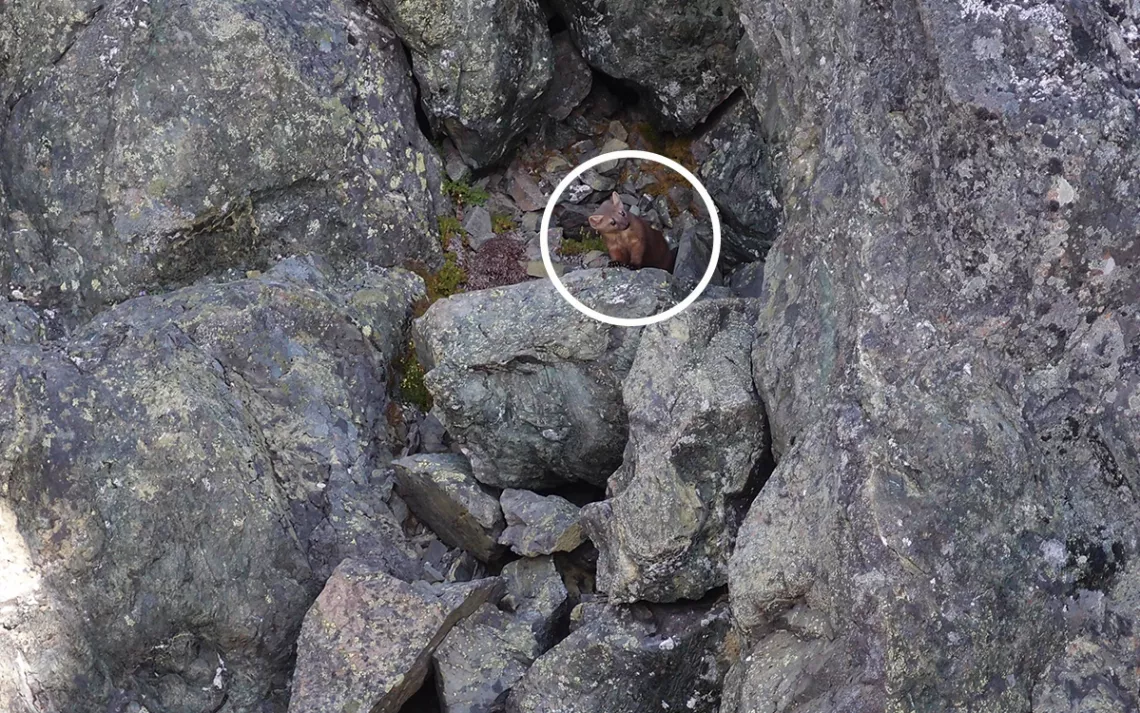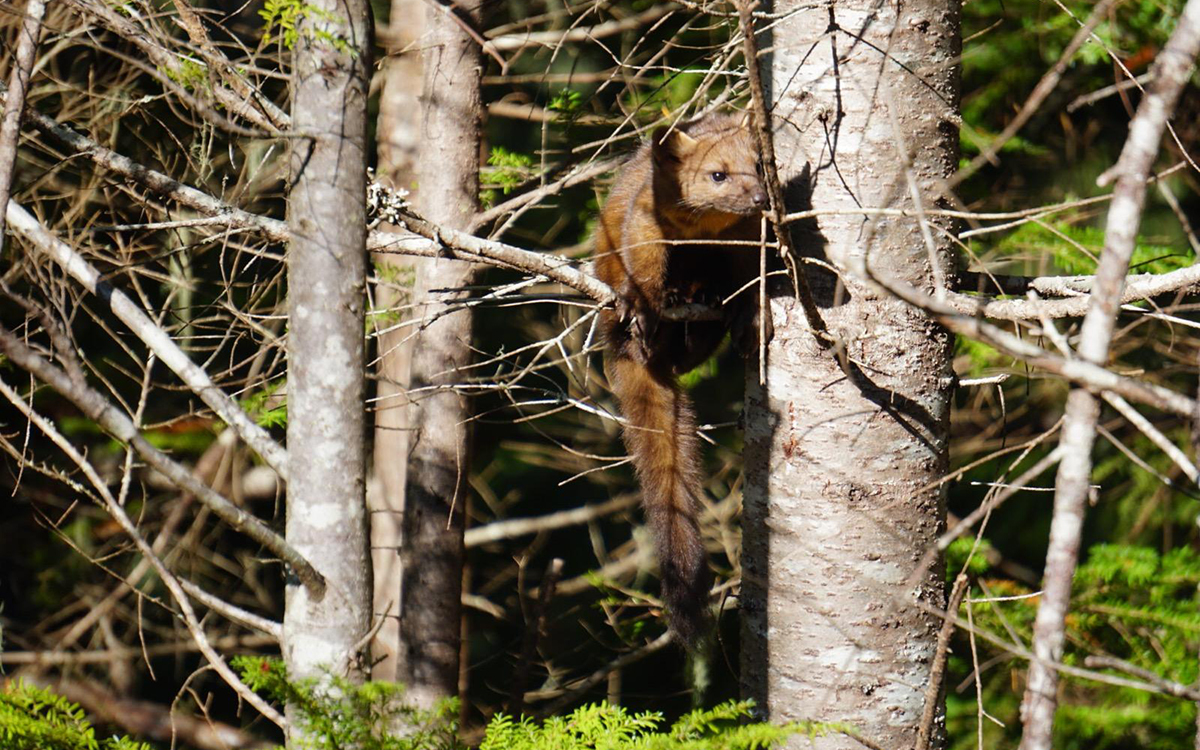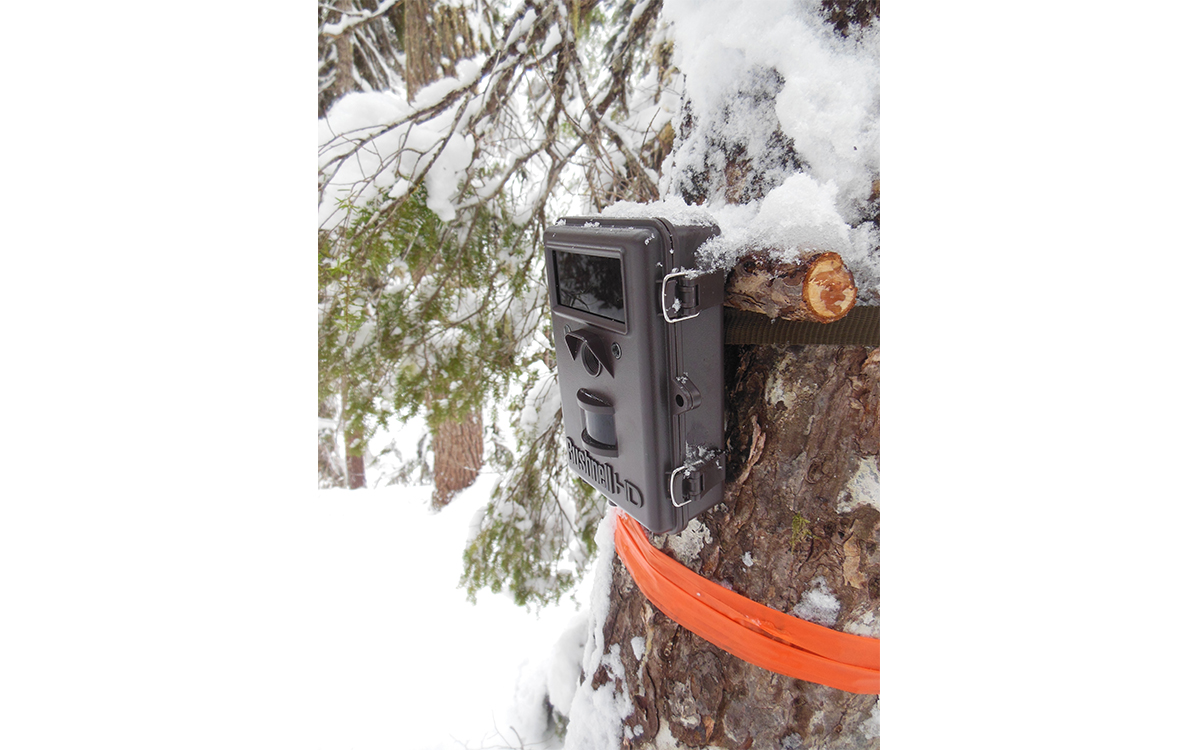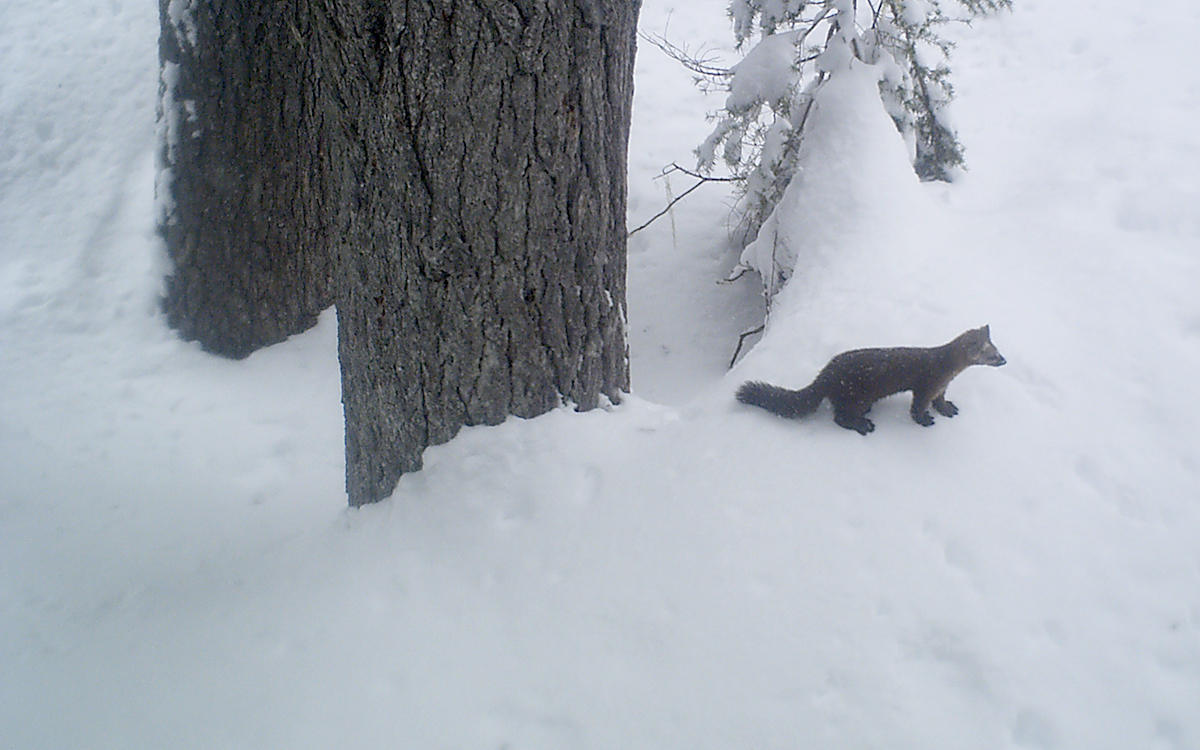The Mystery of the Missing Martens
It takes a village to find an elusive weasel

A Pacific marten spotted by a rock climber in 2015 | Photo courtesy of Shemuel Harding
In the first half of the 20th century, biologists reported that Pacific martens—a medium-size weasel with relatively large ears that give it a kittenish look—were found on the peninsula “from saltwater to timberline.” These tiny predators thrive in snow and play a big role in keeping populations of mice and voles in check, especially in winter. But when Betsy Howell, a wildlife biologist, moved to the Olympic Peninsula in 2004, nobody had seen a Pacific marten in over a decade. The last person to spot one was a scientist studying spotted owls.
Pacific martens had remained common in the nearby Cascade Mountains. But the ones on the peninsula seemed to have vanished—possibly done in by early-20th-century logging, overtrapping, or the changing climate. No one knew for sure.

A Pacific marten | Photo courtesy of J. Bloomfield
Then, in 2008, two things happened. First, the fisher, another species of weasel that had completely disappeared from Washington State, was reintroduced to the Olympic Peninsula by a partnership of federal and state agencies, tribes, and nonprofit organizations as a step toward statewide restoration. That same year, a young Pacific marten was found dead on a hiking trail in the peninsula’s southeast corner. It was the first sign in nearly two decades that there were still a few in the area—and that they might be reproducing.
As a wildlife biologist for the US Forest Service, Howell says it’s her job to learn what she can to maintain species and biodiversity in national forests. To learn more about Pacific martens, Howell set up a handful of years-old trail cameras, borrowed from her previous Forest Service posting. The cameras captured photos of some fishers but no martens.

A camera trap in winter | Photograph courtesy of Mason White
That didn’t mean that there weren’t martens deeper in the backcountry. Because the animals flourish in snow, Howell thought that if she could set up camera traps during the winter months, she had a good chance of spotting any martens that might still be on the peninsula. But doing that would require hiring seasonal wildlife biologists to help, and Howell didn’t have the budget.
Then, in 2013, support arrived via Adventure Scientists, a nonprofit organization that pairs outdoorspeople with scientists for research projects. In those early years of the organization, its founder, Gregg Treinish, often reached out to scientists working in locations popular with wilderness enthusiasts to find volunteer opportunities.
One of the 20 volunteers Treinish recruited was Mason White—a Seattle-area tech worker with a biology degree. The most important skill required for the study wasn’t a science background though—it was the outdoor skills to handle the backcountry in winter. White, who had volunteered in the past doing search and rescue with the Mount Rainier Nordic Patrol, qualified.
Howell showed White and the other volunteers how to bait the camera traps—by wrapping pieces of chicken in wire “burrito style” and nailing it to a tree.

A chicken-wire burrito placed in 2014 | Photo courtesy of Mason White
White and another volunteer drove out from the Seattle area every two weeks, leaving early Saturday morning. In one long, exhausting day, they would drive into the national forest until they hit snow, put on cross-country skis, and ski until they ran out of road, then put on snowshoes and hike. Once they reached the site, they would nail up a fresh burrito, replace the batteries, and collect the photos.
White couldn’t resist looking at the previous two weeks’ photos. In one of the night-vision shots, he spotted a low-slung creature with a long tail, its eyes shining. White’s heart raced. Could this be the Pacific marten they were seeking?
Excited, he showed it to Howell. It was a mink.
During the two years of the citizen science surveys, White and the other volunteers collected 21,842 photos of wildlife for Howell: elk, bobcats, coyotes, fishers, and even a mountain lion. But never any martens.
Still, White doesn’t regret all the hours he spent. His science background had prepared him for a null result. “I’m glad that we were able to provide data,” he says. “I understand that even negative data is important.”
For Howell, the work done by the volunteers did move her research forward—it led to funding from an inter-agency program of the US Forest Service and Bureau of Land Management to have seasonal wildlife biologists search for martens. “We were able to demonstrate that we were putting out the effort but still not finding martens.”
Then, in June 2015, a camera survey searching for fishers on the Olympic Peninsula turned up one photo of a marten. That same month a rock climber snapped a photo of a marten at a popular climbing location.
The following year, a marten camera survey focused on even more remote locations with elevations up to 5,250 feet on the peninsula captured photos of one marten.
Howell and her colleagues with Olympic National Park, the U.S. Geological Survey, Washington Department of Fish & Wildlife, and the Forest Service’s Pacific Northwest Research Station believed that if there were more martens on the Olympic Peninsula, enough for a breeding population, they would most likely be spotted at the highest elevations during the winter. Fortunately, the newer trail cameras then being sold could run six months or more on one set of batteries and store thousands of photos. Howell only needed to figure out how to reach those locations to replace bait and lure when snow made travel impossible.
She didn’t wonder for long. In 2017, she met Robert Long, a biologist who researches the carnivores of the Northwest for Seattle’s Woodland Park Zoo. Long had been studying wolverines, which are truly creatures of the snow, at even higher elevations. He had run into the same problem and had found a solution.
Long had collaborated with a Microsoft engineer and a biologist from Idaho to create a battery-powered device that squirted a few drops of an exceptionally smelly scent lure every day for six months to a year. Without the need to nail up chicken burritos, Long could put up a camera and the scent dispenser in the fall and return in the spring to collect the photos.
High in the Olympic Mountains, at elevations up to 4,760 feet, Howell, Long, and their team installed six sets of cameras and scent dispensers on trees, 12 feet above the ground in anticipation of deep snows. The chicken bait wasn’t necessary any longer, but they left a bone hanging from a tree anyway.
Howell had to wait until spring to see if it worked. When she finally got the chance to check the 2,000-plus photos, two of the six cameras had captured photos of martens.
In the summer of 2018, Howell, Long, and their colleagues installed 31 cameras, this time at elevations up to 5,180 feet. When data cards were collected the following summer, 11 of them had captured photos of martens. “This was extraordinary,” Howell says. They found martens at four areas of Olympic National Park, and most were at elevations over 3,000 feet.

Marten spotted by a camera trap in winter 2019 | Photograph courtesy of Betsey Howell/US Forest Service
In 2019, luck struck again. A researcher studying marmots saw a marten on two different days in August. Two months later and seven miles away, a private forestry consultant also spotted a marten.
“With this species proving difficult to detect and because of the concern over its conservation status, every report is valuable,” Howell says. Even these random sightings add to the scientific knowledge of this population of Pacific martens because it shows how widely they are distributed across the peninsula.
Fifteen Pacific marten sightings in four years seems like an abundance of sightings for a creature whose presence on the Olympic Peninsula was uncertain even a few years ago. Howell could be celebrating, but instead, she’s thinking about the work ahead. She wants to know whether the subpopulations of martens on the peninsula are related to one another and if there are other subpopulations they haven’t found yet. She wants to know if the martens on the Olympic Peninsula are healthy. In addition to these questions, there is the mystery of how martens went from common to rare on the Olympic Peninsula in the first place—if that is answered, different agencies can take steps to make sure they continue to thrive in the area.
To help answer those questions, Howell and her colleagues will head deep into the Olympic National Forest any day now to install more cameras and scent dispensers—the research is socially distanced enough to not be threatened by the COVID-19 pandemic.
“At the moment,” Howell says, “things look better than they have in a long time, but there are still questions. Lots of questions.”
 The Magazine of The Sierra Club
The Magazine of The Sierra Club



